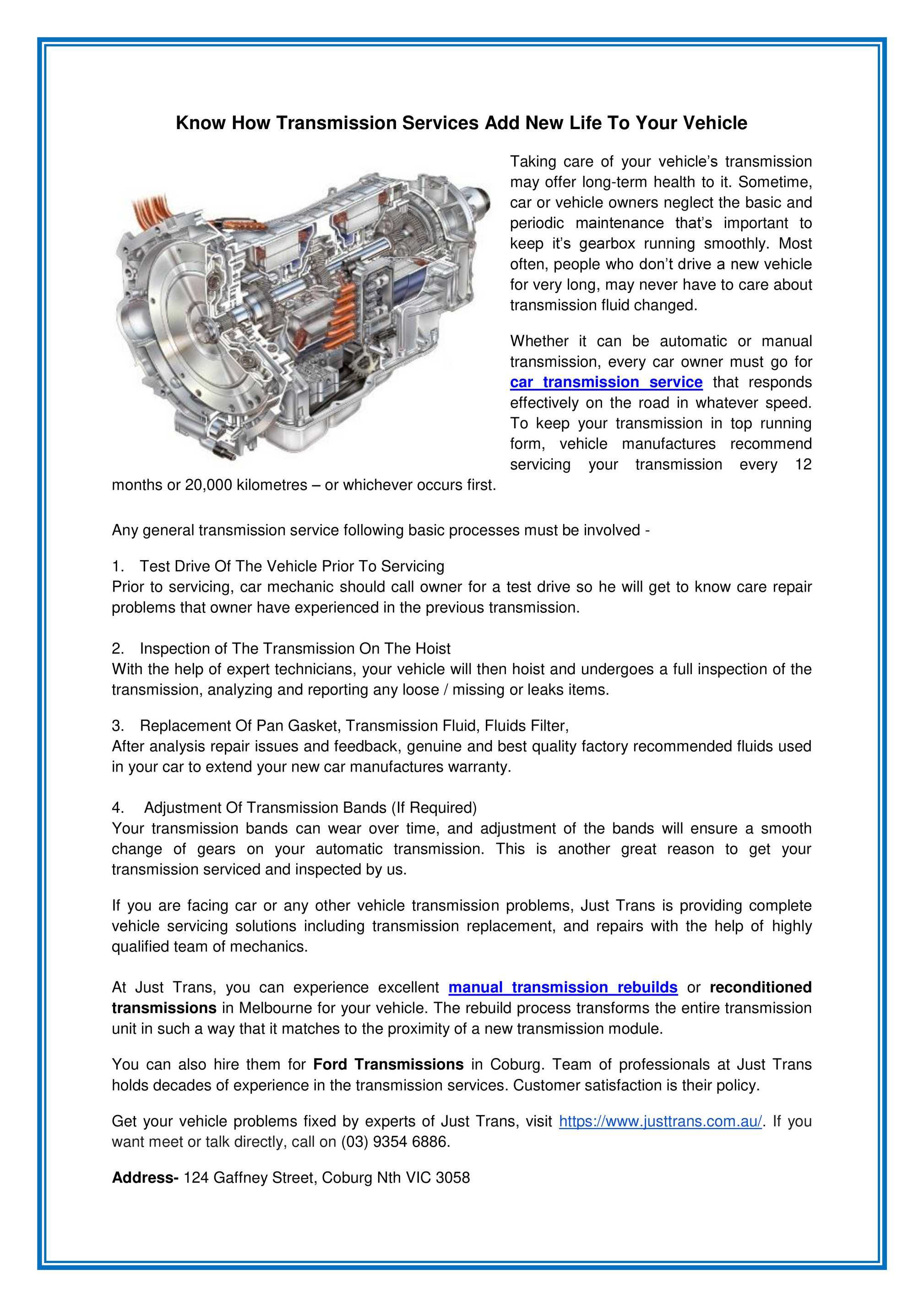If you've been shopping for a new car recently, you've undoubtedly found that large numbers of late-model vehicles are equipped with a continuously variable automatic transmission (CVT). Vehicle Transmission. The term vehicle transmission refers to the transmission of pathogens through vehicles such as water, food, and air. Water contamination through poor sanitation methods leads to waterborne transmission of disease. Waterborne disease remains a serious problem in many regions throughout the world.

Castrol 06814 Transmax Import Multi-Vehicle Automatic Transmission Fluid Castrol Transmax Import Multi-Vehicle is designed for use in most Honda, Toyota and Nissan vehicles as well as many other imported brands. It exceeds the requirements of the JASO-1A performance standard created by Japanese auto manufacturers. It also exceeds DEXRON-IIIH.
Infectious diseases and even certain contagious diseases spread through the following agencies. Their ways of spreading is also given along with these agencies.
1. Air-borne transmission
2. Contact transmission-direct and indirect
ADVERTISEMENTS:
3. Vehicle transmission (Water, milk, food etc.)
4. Vector-transmission
5. Tran placental transmission
1. Air-borne Transmission:
Air is very important carrier of infectious disease. While a person breathes, coughs or sneezes, he sprays out certain infected droplets. The air carries these infected droplets away where they enter into the body of a healthy person.
Sometimes while breathing we inhale certain dust particles that are infected. These infected particles also cause certain diseases. Given below is a list of certain diseases that are spread by air:
(a) Cold and cough,

(b) Influenza,
ADVERTISEMENTS:
(c) Measles, Small-pox, Chicken-pox etc.
(d) Whooping cough,
(e) Diphtheria,
(f) Tuberculosis.
2. Contact Transmission:
It is another cause, and a pertinent one for the spread of certain infectious diseases. Generally persons who look after certain patients suffer from these diseases. This contact may be of the following types:
(a) Personal contact i.e. coming in physical contact with patient. The disease agent is transmitted directly from an infected individual to a susceptible host, during physical contact. In classroom it is quite possible for a boy suffering from some infectious disease to come in contact with other boys, whom he may pass infection.
(b) Sometimes dirty hands are also responsible for carrying the germs of certain infectious diseases such as Polio Myelitis, dysentery, etc. These diseases are very common with some children and so they should be trained to keep their hands clean and free from dirt.
ADVERTISEMENTS:

Given below is a list of the diseases that are contacted in this way:
(i) Ringworm,
(ii) Small pox,
Used Transmissions Prices
(iii) Scabies,

(iv) Impetigo,
(v) Scarlet fever,
(vi) Eczema
3. Vehicle Transmission:
According to Park vehicle transmission implies transmission of the disease agent through the agency of water, ice, milk, food, serum, plasma or other biological products, of these, water is most important vehicle of transmission in many areas of the world because it is used by every one. Cholera, typhoid fever and viral hepatitis are outstanding examples of diseases transmitted by vehicle transmission.
Fly is the strongest carrier of the infection. If it sits on a food, it spoils it. At one hand it sits on the sputum of a patient and on the other hand it sits on the food. Generally it is the fly that makes the drinks infected. Sometimes dust particles also discharge this function. Given below is a list of the diseases that are caused by infected food and drinks: –
(a) Cholera,
(b) Dysentery,

(c) Enteric fever,
(d) Diphtheria,
(e) Scarlet fever,
(0 Typhoid,
(g) Tuberculosis etc.
4. Vector Transmission:
According to Park, Vectors are arthropods or other invertebrate hosts, which transmit infection by inoculation into the skin or mucosa by biting or by deposit of infective material on the skin or on food or other objects. Vectors transmit disease in two ways (a) Mechanical Transmission.
The disease agent is carried mechanically on the legs or body of the insect, e.g. diarrhea, dysentery and typhoid fever by the housefly, and (b) Biological Transmission. This may be of three types (i) Propagative. The disease agent multiplies and increases in the insect vector e.g; plague bacilli in rat fleas, (ii) Cyclo propagative the parasite undergoes a cycle of development in the body of insect host with multiplication e.g. malaria parasite in mosquito, but increase its progeny, (iii) Cycle development.
The parasite undergoes a cycle of development without multiplication e.g. filarial parasite in culex mosquito and guinea worm embryo in Cyclops.
5. Tran placental Transmission:
Some diseases have been known to be carried tran placentally from infected mother to foetus in uterus e.g., syphilis, rubella, measles, toxoplasmosis. It is not known why in some cases the foetus escapes and in others it gets infected.
Related posts:
Top 10 reasons why your transmission may be failing
You know your vehicle. So when it starts acting differently, you take notice. Are you currently hearing strange sounds or is there a peculiar smell coming from your vehicle? Is it handling differently than normal on the road? The most important thing is properly diagnosing the root cause of your vehicle's issue. Below are the tops reasons or signs that you may require transmission repair:
The top signs why your transmission may be failing:
AAMCO is the most trusted name in transmission repair and has been for over 50 years. What sets us apart is our comprehensive diagnostic approach, along with the knowledge and expertise to pinpoint the root of your transmission issue. You may be experiencing a problem with your transmission if your vehicle is exhibiting any of the following symptoms below:
- Transmission won’t engage or stay in gear
If when you put your vehicle into gear and it won’t move, this may be a problem with low transmission fluid due to a leak, the shifter, shifter cable, or it could even be a problem in the valve body of your automatic transmission. Newer vehicles depend on the computer to tell the transmission when to go into gear based on your selection and you may need to have the computer system checked for trouble codes. - Shifts are delayed or missing gears
If your transmission takes a while to go into gear, you may have a low transmission fluid condition because of a leak or contamination due to lack of maintenance or even water intrusion during off road or flooding conditions. While this may not sound serious, but this can also create an overheating condition that can damage internal transmission parts. Other possibilities could be an engine related problem that will cause the computer to not allow the transmission to shift into higher gears. - Transmission slipping or engine is revving high
This condition can also be caused by low transmission fluid, contamination due to lack of maintenance or water intrusion, or internal wear and tear on the transmission parts inside the transmission. A high revving engine is a typical sign that you have worn clutches or other parts inside the transmission going bad. Read more about common causes and signs for a slipping transmission. - Transmission fluid is leaking
A red fluid under the vehicle is a sign that you probably have a transmission fluid leak from one of the cooler lines, a gasket or a seal. This is not only bad for the transmission but is also dangerous if the fluid leaks on a hot pipe or other surface. Check your dipstick for proper fluid level and condition. Note: not all transmission fluid is red and not all levels can be verified with a dipstick method, but require specials tools. - If there’s a burning smell
A burning smell is typically caused by a fluid leak or in some cases by low fluid causing a burning clutch smell. If you catch the fluid leak quickly you might be able to save the transmission from damage. Check your transmission dipstick as per the manufacturer’s direction for level and condition. - If there is buzzing, clunking, humming noise
A buzzing, clicking, humming, roaring noise from inside the transmission is usually a symptom of a bad bearing, planetary gears damage, or other internal problem. A buzzing could also come from a bad internal sealing surface, a seal, or low transmission fluid due to a leak. - Car has no power
If the vehicle has no or little power and the engine is running correctly, this could be from internal transmission problems, brakes that are dragging due to a faulty caliper or brake hose, or your computer in the vehicle is limiting power because of a problem it has detected in order to protect the engine. Have the vehicle checked for trouble codes to isolate the problem. - Check Engine Light or Over Drive Light is on
A check engine light is not dedicated to the engine only. A check engine light can also tell you that you have problems with the transmission including overheating, solenoid problems, speed sensors, slipping transmission and many other problems. Have the trouble codes retrieved to see what systems and circuits are indicating a problem. While not all sensor related codes mean the sensor is bad or will repair the issue, it will give you a starting point for the concern.
Manual Transmissions:
Although not as common, many drivers still choose to drive manual transmission vehicles (also known as manual shift, stick shift cars)
Vehicle Transmission Assembly
- Gears are grinding when shifting
When your manual transmission grinds when shifting gears that is typically a condition related to the clutch not releasing, the shift synchronizer rings inside the transmission itself worn or broken, or a shifter wear or adjustment problem. Transmission oil/fluid that is low, dirty or the wrong fluid can also cause this problem in manual transmissions. - The clutch pedal grabs very low or very high
A clutch pedal that engages very low is typically a problem with the linkage or hydraulic system that operates the clutch. A simple adjustment or bleeding might solve this if there are no hydraulic leaks. A clutch pedal that grabs very high could be an adjustment, or more likely a worn clutch disc and pressure plate.
